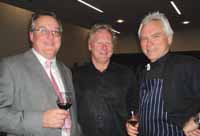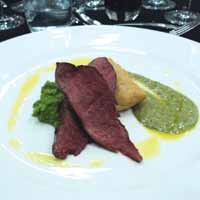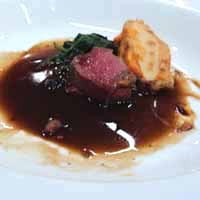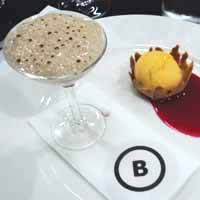2010 Wine & Wild Food Dinner
by Media Officer Rachael Andrews
Australian Shooter May 2011
The old saying goes that if you give a man a fish, you will feed him for a day, but if you teach a man to fish, you will feed him for a lifetime. The Conservation and Hunting Alliance of South Australia (CHASA) took this adage quite literally when it began organising a dinner showcasing wild meats cooked in new and exciting ways. The dream became a reality at the sell-out Wine & Wild Food Dinner at Sanctuary Restaurant in Adelaide last October, when more than 100 guests were treated to a five-course degustation dinner created by native food chef Andrew Fielke and wines matched by Angove winemaker Tony Ingle.

Angove Family Winemakers
winemaker Tony Ingle with David
Sly from SA Life magazine and chef
Andrew Fielke celebrate a successful
evening of wild food and good wine.

Wild duck leg samosa and seared
breast with spiced river mint and
pea purée.

Adelaide Hills venison with sweet
potato spring roll, stir-fry warrigal
greens and native currant glaze.

The rainforest-inspired dessert
with coconut lemon myrtle sago
pudding, Davidson plum coulis
and mango macadamia gelato. The evening was a true representation of how a hunter could take food from the wild and turn it into a gourmet meal. Dinner organisers were delighted with the evening’s success and CHASA chairman Tony Sharley said it was hoped that those who attended were inspired by the exceptional quality of the dishes that were created from wild food.
“There’s times when the hunting fraternity doesn’t do enough to promote the value of what it can do for the environment,” Tony said. “This is a great opportunity to promote the fact that healthy food comes from a healthy environment.
“Hunting skills provide us with the capability to feed ourselves for a lifetime and the opportunity to stay connected with our environment.
“This dinner showed how exceptional game meat can be when it’s cooked by a world-class chef and it has hopefully inspired the people who attended to think beyond supermarket meats and to consider new ways of preparing the meat from their hunt.”
The wild meat for the event was supplied by members of the South Australian Ferret Association, Australian Deer Association, Working Gundogs Association of Australia, Hellenic Shooting Sports Association of SA, and Field and Game Australia.
The five courses for the evening were all part of a story chef Andrew Fielke was trying to tell his guests. The first course was based on South Australia’s Coorong, with mullet accompanied by muntries terrine, sea parsley and cockle salsa verde with coastal saltbush leaves. The second course was based on the plains environment and featured wild rabbit, desert limes and dates with couscous and coriander salad. The wild duck’s traditional home in a wetland was the theme of the third dish, which included wild duck leg samosa, seared duck breast, spiced river mint and pea purée. The final meat dish of the evening was a rare venison loin from the Adelaide Hills with a sweet potato spring roll, stir-fry warrigal greens and a native currant glaze. The rainforest-inspired dessert course consisted of a coconut lemon myrtle sago pudding, Davidson plum coulis and mango macadamia gelato.
Andrew said he attempted to give guests a real feeling for the food and its environment through each course by using locally found ingredients to accompany each wild food.
“I felt it was important to get a sense of where the wild food came from,” he said. “It is so often true that things that live and grow together go really well together on the plate.”
Native Australian food is a passion that began for Andrew while working in restaurants many years ago. During his time in the food industry Andrew has seen wild meat such as duck, rabbit and venison rise and fall in popularity, with rabbit meat popularity peaking in the 1990s.
“The Australian psyche with food is changing with the MasterChef phenomenon,” Andrew said. “There are more and more people out there looking for interesting food to cook than ever before.”
CHASA chairman Tony Sharley agreed, saying it was dinners such as the Wine & Wild Food Dinner that would help feed this interest as diners were made aware of the origins of their food.
“Today, what we eat has been genetically modified and we really only enjoy a much smaller range of food than what our ancestors did,” Tony said. “Eating wild food is maintaining a much stronger connection with the environment and natural, healthy foods.”
A key objective for CHASA is to promote the benefits of hunting and membership of hunting and conservation organisations in South Australia to allow new hunters to be mentored in field hunting. According to Tony, this function “teaches them how to fish” and allows hunters to reconnect with their environment and visualise how hunting is a deep-seated part of Australia’s culture.
As part of the dinner, Deakin University’s Dr David Roshier, a researcher interested in waterbird and migratory patterns, gave a talk titled ‘Waterfowl - Here Today, Gone Tomorrow and Back the Day after That’. His studies in recent years of ducks moving between wetland areas in Victoria, New South Wales and South Australia illustrated the complex migratory paths these birds travel - often several hundred kilometres in just a few hours and always at night.
Guests were also privy to presentations by chef Andrew and winemaker Tony Angove about the particulars of matching food and wine for the event.
CHASA is looking forward to making the Wine & Wild Food Dinner an annual event, with plans already underway for a 2011 feast.
Tagine of rabbit with sunrise limes and orange couscous
by Andrew Fielke
serves 2-3
Rabbit meat lends itself beautifully to this classic Moroccan-style braise. As the loin in particular dries out when well done, I like to set this aside and braise the other cuts, which remain more succulent after slow cooking. Then, just before serving the dish, you can quickly sear the loin fillets, keeping them pink in the middle. The addition of chopped sunrise lime and dates at the end give a lovely fruity lift, picking up the fruit in the wine [the Angoves wine that accompanied the dish].
Rabbit ingredients
• 1 medium-size rabbit (1.3-1.5kg)
• 50g butter
• 200g onions - thickly sliced
• 2-4 garlic cloves - finely chopped
• 1 small bunch coriander
• 1 teaspoon ground ginger
• 1 generous pinch saffron threads
• 1 dessertspoon hot paprika
• 1 teaspoon pepperleaf ground
• 1 teaspoon ground black pepper
• ½ teaspoon salt
• 1.5 litres rabbit or chicken stock
Preparing the rabbit
First, with a boning knife, remove the hind and fore legs from the rabbit. Cut the large hind legs into two or three pieces, removing the bones if you wish. Bone the loin fillets from the back of the carcass and reserve them for cooking later. Your butcher may bone-out the meat for you on request. You can make a simple stock with the rabbit bones, carrot, onion and celery or use a prepared chicken stock in the braise.
Braising the rabbit
Heat the butter in a heavy-based braising pan and add the rabbit leg portions. Brown the meat on all sides, remove and set aside.
Add the sliced onions and garlic and simmer for 10-15 minutes over a gentle heat until light golden brown.
Next, add the finely chopped coriander roots (reserve the leaves for later), spices, seasonings, browned meat and stock. Bring the pan to the boil and simmer gently for 15 minutes until tender - this varies depending on the age of the rabbit.
Remove the meat, cover with plastic and set aside. Continue to simmer the sauce down to a third of the volume, skimming regularly to remove any fat.
Couscous ingredients
• 1 cup water or chicken stock
• 1 cup orange juice
• olive oil
• ½ teaspoon salt
• 1 cinnamon stick
• 4-5 aniseed myrtle leaves (optional)
• 2 cups couscous
• zest of ½ orange - finely chopped
Couscous method
Bring the water, juice, 1 teaspoon of olive oil and salt to the boil with the cinnamon stick and aniseed myrtle leaves. Pour the boiling liquid over the couscous, stir well and cover tightly with plastic and allow to cool completely and swell up. Stir in the orange zest.
Remove the leaves and cinnamon stick and stir in olive oil to moisten. Pack firmly into individual greased soufflé or dariole moulds and cover with plastic, ready to reheat in the microwave.
Serving ingredients
• 4 sunrise limes - coarsely chopped (cumquats are a nice alternative)
• 4 fresh dates - coarsely chopped
• 1 dessertspoon olive oil
• salt and pepper
Serving method
Add the braised leg meat, limes and dates to the reduced tagine sauce and simmer briefly to heat through.
Sear the reserved rabbit fillets in the olive oil, season to taste and cook to medium; rest the meat in a warm place for 5 minutes.
Reheat the couscous and turn out onto plates. Arrange the carved rabbit fillets and the tagine alongside and sprinkle with the reserved coriander leaves, coarsely chopped.
